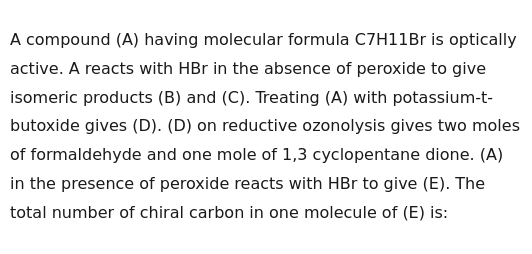Question
Question: A compound (A) having molecular formula C7H11Br is optically active. A reacts with HBr in the absenc...
A compound (A) having molecular formula C7H11Br is optically active. A reacts with HBr in the absence of peroxide to give isomeric products (B) and (C). Treating (A) with potassium-t-butoxide gives (D). (D) on reductive ozonolysis gives two moles of formaldehyde and one mole of 1,3 cyclopentane dione. (A) in the presence of peroxide reacts with HBr to give (E). The total number of chiral carbon in one molecule of (E) is:

1
Solution
We shall show a “back‐of‐the‐envelope” reasoning using the following clues.
Step–1. It is given that A (C₇H₁₁Br) is optically active (so it has one stereogenic centre) and that treatment with “HBr in the absence of peroxide” (i.e. the ionic – Markovnikov – process) gives two isomeric products (B and C). Also, on treatment with potassium‑t‐butoxide A eliminates HBr to give D. Finally, ozonolysis of D “reduces” the carbon–carbon double bonds to yield two moles of formaldehyde plus one mole of 1,3‑cyclopentanedione.
The ozonolysis result shows that D must be a diene whose two CC double bonds lie in such a way that on cleavage the exocyclic “=CH₂” groups give CH₂O (each) while the remaining ring, now oxidized at the two points of attachment, becomes a 1,3‑diketone. In other words, D is best deduced as
1,3‑bis(methylene)cyclopentane [with formula C₇H₁₀; note DU = 3].
Step–2. Since A gives D by elimination of HBr the precursor A must be the “addition” product of HBr to D. (In ionic addition the –H attaches to the –CH₂ group and –Br adds to the ring–CH carbon.) In that ‘ionic’ product (namely A) the Br is located on a ring‑carbon which becomes stereogenic (hence A is optically active) and two regioisomers (B and C) are possible.
Step–3. Now, when A is reacted with HBr in the presence of peroxide the addition proceeds by a radical mechanism. In one important difference the regio‐selectivity is reversed: the bromine now adds to the –CH₂ side (the “less‐substituted” carbon) while H goes on the ring carbon. (Compare: ionic (no peroxide) gives Br on the ring carbon; radical (peroxide) gives Br on the exocyclic carbon.) Thus the product E now has the Br attached to a –CH₂ group. Since that –CH₂Br group has two hydrogens it is not stereogenic. However, the ring–carbon (which gained H in the radical process) now becomes tetra‐substituted with its four “branches” (the two ring–paths become nonequivalent because the ring also bears a =CH₂ group at the other position) and becomes chiral.
Thus in (E) only one carbon (the one on the ring which “received” H in the radical addition) is stereogenic.
To summarize very briefly:
• D is deduced as 1,3‑bis(methylene)cyclopentane. • “Ionic” addition (no peroxide) to D gives A (and its isomers) having Br at the ring–centre making that carbon chiral. • In “radical” addition (with peroxide) the regiochemistry is reversed so that Br attaches to the exocyclic –CH₂ (which remains achiral) and the ring–carbon now bears a new H with its four substituents rendered different. • Hence, (E) has exactly 1 chiral centre.
Minimal Explanation:
- From ozonolysis we deduce D = 1,3‑bis(methylene)cyclopentane.
- A is its HBr‑addition product (ionic, Markovnikov) having Br on the ring–carbon (making A optically active).
- Under peroxide conditions (radical addition) the regio‑selectivity reverses so that Br attaches to the –CH₂ group (which is not chiral) while the ring–carbon (getting H) becomes a stereocentre.
- Thus, molecule (E) contains one chiral carbon.
